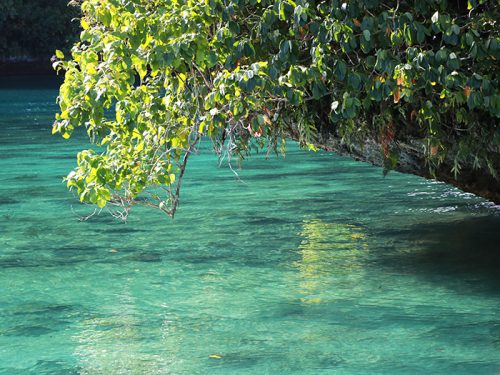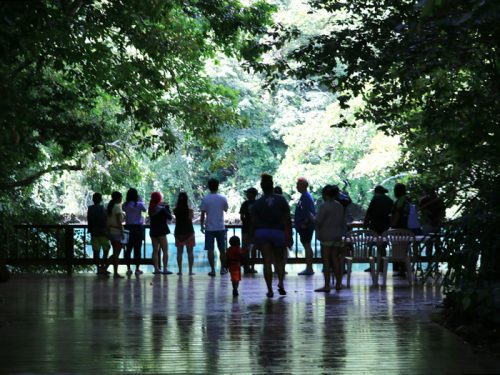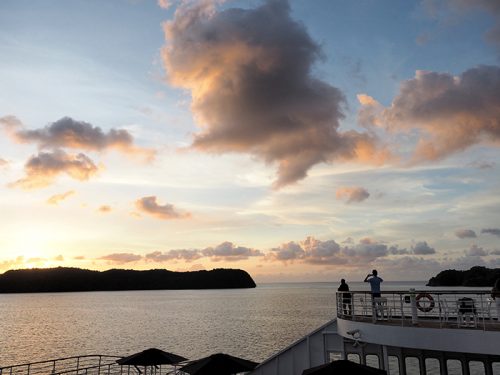前往蔚藍的海與天融合一體的世界遺產島嶼
2021/07/30
柯羅(帛琉)
靛藍、鈷藍、海洋藍…等待著我們的是各式各樣的「藍」相互爭豔的世界遺產海洋――位於太平洋上的帛琉共和國,其海洋中孕育著超過千種的生物,是一個保留著純樸大自然的島國。不論是海上或是山上,都可以享受到各種不同的活動,而這個人口未滿2萬人的國家,每年卻有高達16萬人次的觀光客到訪,但同時現實中稀有自然環境卻也正面臨著危機。而我們在這樣的帛琉中遇到的是,為了將美麗景觀留給未來的「某種約定」。這是一種劃時代的方式,讓到訪的人可以在意識中帶來改變,並且也試圖改變南方樂園的未來。

世界遺產洛克群島
黎明時分,當船的速度減緩時,我們來到了甲板上,朝陽緩緩地上升,海中也浮現出了島嶼的影子。這就是洛克群島,以大大小小400多個島嶼組成,也是帛琉所自豪的世界遺產。如同蘑菇形狀的奇特外型,是因為石灰岩的島嶼經過數萬年的潮汐與生物的侵蝕而成。這裡棲息著數百種珊瑚及種類多樣的生物,並且也發現3000年前人類在此活動的痕跡。在寧靜的朝陽照射下,島嶼,大海,天空漸漸被染上了色彩ーー不知不覺中,甲板上就聚集了許多人潮,一起欣賞著這讓人無法言語的神秘景色。

乳白色的海灣,牛奶湖
到了帛琉本島之後,這次我們改搭乘小船再度出海。一邊淋著飛濺的水花一邊滿心期待著,隨後我們所到達的地方是之前從遊輪上所看到的被洛克群島所圍繞的海灣,牛奶湖。在這個沒有波浪的鈷藍色海灣中,嚮導突然跳進海裡,並用手在海底挖起乳白色的泥巴。原來是從島上溶解出來的石灰岩,變成泥巴沉澱在海底。如果塗上這個泥巴,因為富含礦物質的緣故,還有保濕美肌的效果喔。大家互相取笑著全身被塗白的模樣,並等到乾了之後就直接往海裡跳下去!一切都被泥巴沖掉的感覺,實在是幸福至極,讓人不由得閉起了眼睛享受這一刻。

在茂密的叢林之處
北部的巴別塔島是帛琉翠綠的代表場所。只要進入蔥鬱茂盛的叢林之中,就可聽見風吹過樹梢,群鳥鳴叫的聲音,瞬間自然的生命力灌滿了全身。在嚮導的帶領之下,我們在森林之中向前邁進,在目的地等待著我們的是帛琉最大的瀑布,安德貌天使瀑布。面對著落差30公尺,寬37公尺的瀑布,每個人興奮之心越發高漲,也越往瀑布底潭靠近。瀑布流洩下來的水變成水霧,讓周圍充滿了負離子。雖然帛琉給人很強烈的海洋印象,但也有保有太古時期樣貌的森林,讓人感受到與自然融為一體的場所喔。

在和平降臨的島嶼上
在充分享受完海洋與叢林之後,我們來到帛琉的中心地點,柯羅島。到了這邊就要趕緊填飽已經空空的肚子,所以我們走進了一間沿海的餐廳。我們點的餐點是,帛琉的特色料理紅樹林蟹。蒸熟的螃蟹,全身到蟹爪都是扎實的蟹肉!吃起來比想像中的更加美味!走在帛琉的街上時,常常會看到日文的看板,原來是日治時期時所遺留下來的。位於南部的貝里琉島,曾經是太平洋戰爭的激烈戰場,如今那些激戰的傷痕仍隨處可見。現在能夠稱讚這個島嶼「美麗」,也是因為和平到來的關係。看著海浪一陣一陣的拍打而來,心中感受到因為和平所以才讓旅行成為可能。

與帛琉的孩子們的「約定」
到了帛琉以後,常常可以看到以及聽到一句話,那就是『帛琉誓詞 (Palau Pledge)』。這是觀光客在入國前所要簽署的「守護帛琉自然」的誓詞。帛琉誓詞的最大特色是,這個誓詞的起草是與帛琉的孩子們相關。僅管有許多倡導環境保護的法令,但帛琉誓詞是一種更進一步的做法,要為了未來的孩子們訂下保護環境的約定。進行著許多環境保護工作的和平號遊輪,也是帛琉誓詞開始後第一艘抵達帛琉的大型遊輪,並且帛琉的湯米·雷蒙格索總統當時也親訪了和平號遊輪,在典禮進行的同時,我們也一同簽署了該誓詞。

帛琉的子民也簽署了帛琉誓詞。而這也反映了帛琉總統曾說過的「改變需要所有人的承諾」。『 我發誓會輕手輕腳、行事仁善、小心探索。。。』我們在這樣的誓詞上簽署,代表我們在停留的時期將會隨時注意保護帛琉的自然環境,並且尊重帛琉的文化。為了帛琉的孩子們,我們想要守護這片美麗的海洋及叢林ーー在南方的樂園中意外遇見對於“未來的約定”,讓我們了解到不僅僅是旅行的人們,所有人都要對環境負起責任。
PHOTO: PEACEBOAT, Mizumoto Shunya, Matsuribi Toshitatsu
